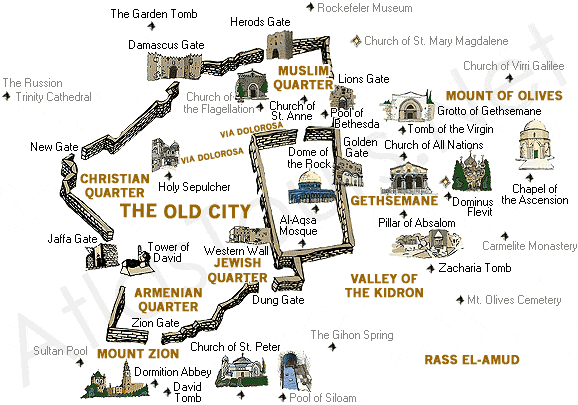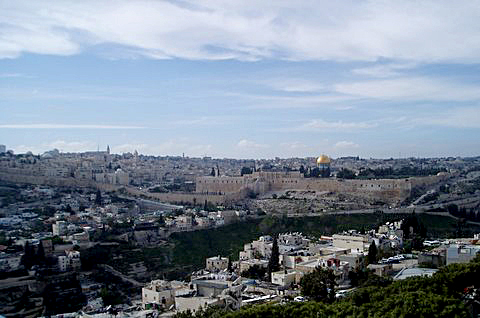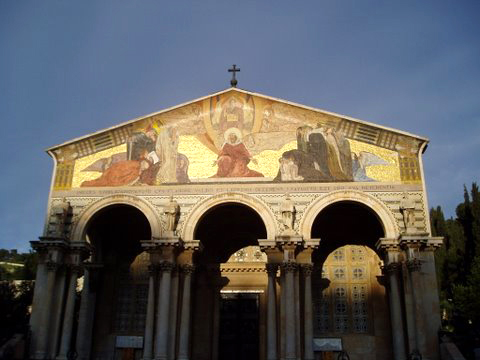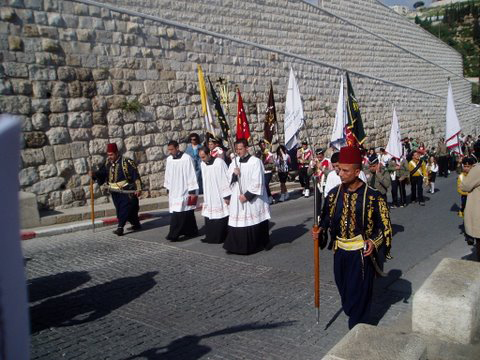Greetings
from Jerusalem
Fr Paul Hannon MSfr
1st April 2010

Dear Family and Friends,
We arrived at St. Anne’s as dawn was breaking and the sight of the Old City seen from the room I was given was breath-taking.
St. Anne’s Basilica is the Crusader church built in the 13th century on the site of previous churches over the cave where – tradition has it – Joachim and Anne lived and where Mary, the mother of Jesus, was born. Down in the crypt, the walls of the cave can be seen and there is an altar where Mass is celebrated. This beautiful Norman-style basilica, built in local limestone which is light oatmeal in colour, stands next to the site of the Pool of Bethesda where Jesus cured the paralytic who had no-one to carry him to the water when the surface was disturbed (John 5, 2-9). The site of the Pool and the Basilica were given to France by the Ottoman Turks in the 19th century as a token of thanks for the help given by France to Turkey during the Crimean War. In the 1870s, the care of the place was entrusted by the Government of France to Bishop Lavigerie of Algiers who had recently founded the Missionaries of Africa. A community of White Fathers was established to be guardians of the site and to build on adjacent land a seminary for the training and formation of priests for the Greek Melkite church. Two large buildings housed the White Fathers’ community, the seminarians and their places of study. It was only in 1967 that, due to the Arab-Israeli war and the resultant changes in territorial boundaries, the seminary was closed and transferred to Lebanon. The buildings now accommodate three communities: the resident White Father community who care for the holy sites within the property and welcome thousands of pilgrims each week; a Small Formation Group of ten White Father students in formation who study theology at a Salesian College nearby and their formator; and the Session/Retreat community made up of two White Fathers responsible for organizing and animating the sessions and the 25 or so participants in the session, these latter present in the house twice a year for a period of three months. St. Anne’s stands next to the Via Dolorosa just inside the Old City beside the Lions’ Gate (or Sheep Gate) on the Eastern side of the walled city facing the Mount of Olives.
|
Only metres away is the Temple Mount in which stands the Dome of the Rock, Mount Moriah, [traditionally said to be the site of Abraham’s sacrifice and, for Muslims, the place visited by Muhammad on his Night Journey and from which he ascended to the seven heavens, a place second only in sacredness and holiness to Mecca], the al-aqsa mosque and the Western (Wailing) Wall of the Temple of Solomon.
The disturbances were sparked by the Israeli Government’s announcement of their plan to build some 1,600 new homes for Jews in East Jerusalem whose population is mainly Arab. Further to this, they announced that two holy sites for the Muslims located in the occupied territories would henceforth be considered Jewish heritage sites – so much provocation and deliberate seeking of conflict! To make matters worse these announcements were made the very day that the American Vice-President arrived to try to get peace negotiations going again. I heard of only one fatality during these disturbances – a youth shot dead near the West Bank town of Nablus. Yesterday and today have been quiet and the numbers of riot police and security forces have greatly diminished.
From the Mount of Olives we walked home past the place where Jesus wept over Jerusalem and the Garden of Gethsemane where ancient olive trees still grow on the hillside. We crossed the Kedron and climbed the slope to enter the Old City once again by the Lions’ Gate. Last Thursday we travelled to Bethlehem to visit the Church of the Nativity. Bethlehem lies outside Israel behind the great hideous wall constructed by the Israelis to keep out ‘terrorists’. A bitterly cold wind was blowing during our visit and we sought shelter in the main Basilica and in the Milk Grotto where Mary is said to have nursed Jesus. From Bethlehem we went to Ain Karem in the wooded, steep hills to the West of Jerusalem ... ‘the hill country of Judah’ ... where Mary hurried to visit her cousin Elisabeth and where John the Baptist was born. Just a short walk away – though a steep enough climb after all the exertions of the day – stands the church of the Visitation where Mary is said to have greeted her cousin. |





